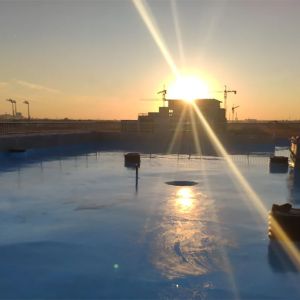| Sign In | Join Free | My himfr.com |
|
| Sign In | Join Free | My himfr.com |
|
| Ask Lasest Price | |
| Brand Name : | Zhuhai Feiyang |
| Model Number : | Corrosion Resistance Mechanism of Polyaspartic |
| Certification : | ISO 9001-2015, ISO 14001-2015 |
| Payment Terms : | L/C, T/T |
| Supply Ability : | More than 20000 tons per year |
| Delivery Time : | 7 days after orders comfirmed |
The environmental benefits of polyaspartic originate from its chemical composition, manufacturing processes, and low environmental impact throughout its lifecycle.
Chemical Structure and Low VOC Characteristics
1.Solvent-Free Formulation
2.Use of Aliphatic Isocyanates
3.Blocking Effect of Aspartic Esters
Eco-Friendly Production Processes
1.Low-Temperature Synthesis
Polyaspartic synthesis occurs at ambient or low temperatures (-40 to 60°C), reducing energy consumption by over 30% and lowering carbon emissions compared to traditional high-temperature (>100°C) polymerization.
2.Zero Byproducts
The reaction between isocyanates and aspartic esters is purely additive, generating no small molecule byproducts (e.g., water, CO₂), thus eliminating waste gas emissions.
3.High Raw Material Utilization
Precise two-component ratios (e.g., 1:1) achieve >99% reaction conversion and <1% material waste, significantly lower than the 10-20% loss typical of traditional coatings.
Environmental Performance During Use
1.Longevity Reduces Renovation Frequency
Polyaspartic coatings last 15-20 years (compared to 5-8 years for traditional coatings), significantly reducing waste generated by frequent renovations.
2.No Harmful Emissions
Fully cured coatings are chemically stable without plasticizer migration (e.g., phthalates) and meet GREENGUARD Gold certification for indoor air quality, suitable for sensitive areas like hospitals and schools.
3.Antimicrobial and Self-Cleaning
Certain formulations incorporate inorganic antimicrobials (e.g., nano silver, zinc oxide), reducing chemical disinfectant use; hydrophobic surfaces reduce water and cleaner usage.
Waste Treatment and Recycling
1.Recyclability
Laboratory studies suggest polyaspartic coatings can undergo thermal pyrolysis to recover isocyanate monomers or physical crushing for reuse in low-end construction materials.
2.Biodegradability Exploration
Research into bio-based polyaspartic (derived from plant-based aspartic esters) indicates potential biodegradability into CO2 and H2O via microbial action.
Environmental Certifications and Standards
Technological Improvement Directions
1.Bio-Based Material Substitution
Developing plant-derived aspartic esters from castor oil and corn starch derivatives to replace petroleum-based materials and reduce carbon footprint.
2.UV Curing Technology
Introducing UV curing systems reduces construction energy consumption by more than 50%.
3.Closed-Loop Recycling
Developing chemical depolymerization methods to achieve 100% monomer recovery from coatings.
The environmental performance of polyaspartic results from molecular design, production techniques, and lifecycle management. Through a solvent-free system, aliphatic materials, and high reaction efficiency, polyaspartic achieves comprehensive environmental protection, making it an ideal replacement for traditional high-pollution coatings. As bio-based and recyclable technologies advance, its environmental advantages will expand further, supporting global carbon reduction goals.
Feiyang has been specializing in the production of raw materials for polyaspartic coatings for 30 years and can provide polyaspartic resins, hardeners and coating formulations.
Feel free to contact us: marketing@feiyang.com.cn
Our products list:
Contact our technical team today to explore how Feiyang Protech’s advanced polyaspartic solutions can transform your coatings strategy. Contact our Tech Team

|




